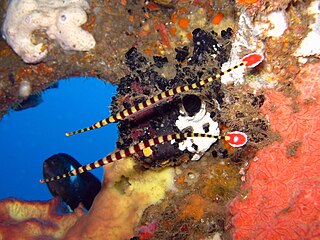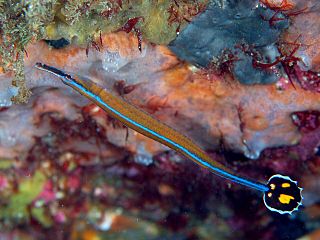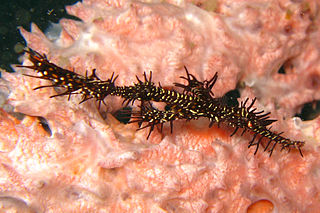
Pipefishes or pipe-fishes (Syngnathinae) are a subfamily of small fishes, which, together with the seahorses and seadragons, form the family Syngnathidae.
The longsnout pipefish is a pipefish of the family Syngnathidae. It has only been recorded from midwater and bottom trawls at depths of 37–212 metres (121–696 ft). The habitat and biology of this species are almost unknown but juveniles have been recorded in the stomachs of blue penguins and Snares penguins.

The lesser pipefish or Nilsson's pipefish is a pipefish similar to the greater pipefish, but with no crest above the head. Usually it reaches up to 17 centimetres (6.7 in) in length, maximally 18 centimetres (7.1 in), although in South Wales they are usually not more than 10 to 13 centimetres long. They have a light to dark green-brown colour with bar-like markings on the sides.

The banded pipefish or ringed pipefish is a species of fish in the Syngnathidae family.

Doryrhamphus and Dunckerocampus, popularly known as flagtail pipefish, are two genera of fishes in the family Syngnathidae. They are found in warm, relatively shallow waters of the Indo-Pacific, with a single species, D. paulus, in the eastern Pacific. Most of these pipefishes are very colourful, and are fairly popular in the marine aquarium hobby despite requiring special care and not being recommended for beginners.

The alligator pipefish or double-ended pipefish is a species of fish in the family Syngnathidae and is the only species in the monotypic genus Syngnathoides. It is found in shallow water in the tropical and subtropical Indo-Pacific, its range extending from East Africa to northern Australia. This fish lives in habitats of seagrass and seaweed, and hides by positioning itself vertically with its head down amidst the similar-coloured fronds of vegetation. The elongated, well-camouflaged body can reach 29 cm (11 in) in length. It feeds by sucking up its prey.

The black-striped pipefish is a species of fish in the family Syngnathidae. It is found in the eastern Atlantic from the southern Gulf of Biscay to Gibraltar, also in the Mediterranean and Black Seas. As the introduced species it is mentioned in the Caspian Sea and fresh waters of its basin.

The ornate ghost pipefish or harlequin ghost pipefish, Solenostomus paradoxus, is a false pipefish of the family Solenostomidae. The species name comes from the Greek paradoxos, referring to this fish's unusual external features. Ornate ghost pipefish are found in the Western Pacific and the Indian Ocean along reef edges prone to strong currents from the Red Sea to Tonga. They reach a maximum length of 12 cm. They vary in color from red or yellow to black and are almost transparent. Although relatively common, ornate ghost pipefish are very well-camouflaged and difficult to find. It occurs either as solitary individuals or in pairs, among the branches of gorgonians, in floating weeds, or crinoids where the feed on mysids and small benthic shrimp.

The messmate pipefish is a species of marine fish in the family Syngnathidae. It is widespread throughout the tropical waters of the Indo-Pacific region, from the eastern coast of Africa to the Vanuatu Islands. This species can reach a length of 19.8 cm. It occasionally makes its way into the aquarium trade where it is known as the dragonfaced pipefish. Other common names are bloodspot pipefish, reef pipefish, reeftop pipefish and yellow-streaked pipefish.
Doryrhamphus janssi, commonly known as the Janss' pipefish , is a species of pipefish belonging to the family Syngnathidae.

Doryrhamphus is a genus of pipefishes, one of the two genera colloquially known as flagtail pipefishes and are popular in the aquarium trade. The members of this genus are native to the Indian and Pacific Oceans where they inhabit reef environments. The species in this genus have a maximum length of 14 centimetres (5.5 in) or less, with D. janssi being the only species that surpasses 8.5 centimetres (3.3 in). Most species have a horizontal blue line along their body, and all have a whitish-edged tail that is marked contrastingly with black, red or yellow.
Syngnathus schmidti, the Black Sea pelagic pipefish or Schmidt's pipefish, is a pipefish species that inhabits the Black Sea and Sea of Azov. A freshwater/brackishwater fish, it can grow up to 11 centimetres (4.3 in) long and usually lives at a depth of 1 to 10 metres, although it can live as deep as 100 metres (330 ft). The specific name honours the Danish zoologist Ernst Johannes Schmidt (1877-1933).
Pelagic pipefish is a pipefish species of the family Syngnathidae.

The shark mackerel is a species of Spanish mackerel in the scombrid family (Scombridae). Their maximum reported length is 112 cm (44 in), and the maximum reported weight is 13.5 kg (30 lb).

Doryrhamphus excisus is a species of flagtail pipefish from the genus Doryrhamphus. Its common names include blue-striped pipefish and blue-and-orange cleaner pipefish. The fish is found throughout much of the Indo-Pacific and tropical East Pacific.
Doryrhamphus aurolineatus is a species of flagtail pipefish from the genus Doryrhamphus that occurs in the Western Indian Ocean. It was named by J. E. Randall and John L. Earle in 1994. The fish may be found near caves, and males carry eggs in a brood pouch under the tail.

Doryrhamphus japonicus, or the Honshu pipefish, is a species of flagtail pipefish from the genus Doryrhamphus that occurs in the Western Pacific Ocean, from Milne Bay, Papua New Guinea, to Sulawesi, Indonesia, the Philippines, and north as far as Honshu, Japan and Korea. It is a marine demersal pipefish that inhabits coastal lagoons, rocky and coral reefs, and tidal pools down to as deep as 30 metres (98 ft) but it is unusual below 10 metres (33 ft). This species is frequently found in association with sea urchins of the genus Diadema and with sponges. It is an active cleaner, feeding on parasites found on other fishes. It frequently shares crevices with shrimps, large mud crabs and occasionally moray eels.

Doryrhamphus negrosensis, commonly known as Negros pipefish, flagtail pipefish, Masthead Island pipefish or Queensland flagtail pipefish, is a species of marine fish of the family Syngnathidae. It is found in the Western Pacific Ocean, from Borneo to Vanuatu and the Yaeyama Islands to the Rowley Shoals and the Great Barrier Reef. It lives in mud flats and reefs, both coral and rocky, where it is often associated with sea urchins. It is a rather solitary species which may be found in pairs or small groups. It inhabits depths to 9 metres (30 ft), and can grow to lengths of 6.2 centimetres (2.4 in). Although little is known of its feeding habits, it is expected to feed on harpacticoid copepods, gammarid shrimps, and mysids, similar to other pipefish, it may also act as a cleaner fish like other species in the genus Doryrhamphus. This species is ovoviviparous, with males carrying eggs before giving birth to live young. Males may brood at 4.3 cm. It is a small bluish to bluish-grey pipefish which has a pale stripe along the dorsal side of the head and snout, and a dark fan-like caudal fin which has white margins and an orange base.

Dunckerocampus pessuliferus, occasionally Doryrhamphus pessuliferus, is a species of marine fish of the family Syngnathidae. It is a coastal species, inhabiting waters around the Coral Triangle, including the Philippines, Indonesia, and northwestern Australia. It lives in coral patches on sandy and muddy slopes at depths of 15–44 metres (49–144 ft), where it can grow to lengths of 16 centimetres (6.3 in). It is an active cleaner, feeding off of parasitic crustaceans growing on other fishes. The adult fish form pairs and are normally observed swimming along the bottom around large remote coral heads on muddy slopes. This species is ovoviviparous, with males carrying eggs and giving birth to live young.
Microphis pleurostictus, the Luzon River pipefish (湖沼腹囊海龍),is a species of freshwater pipefish belonging to the family Syngnathidae.












